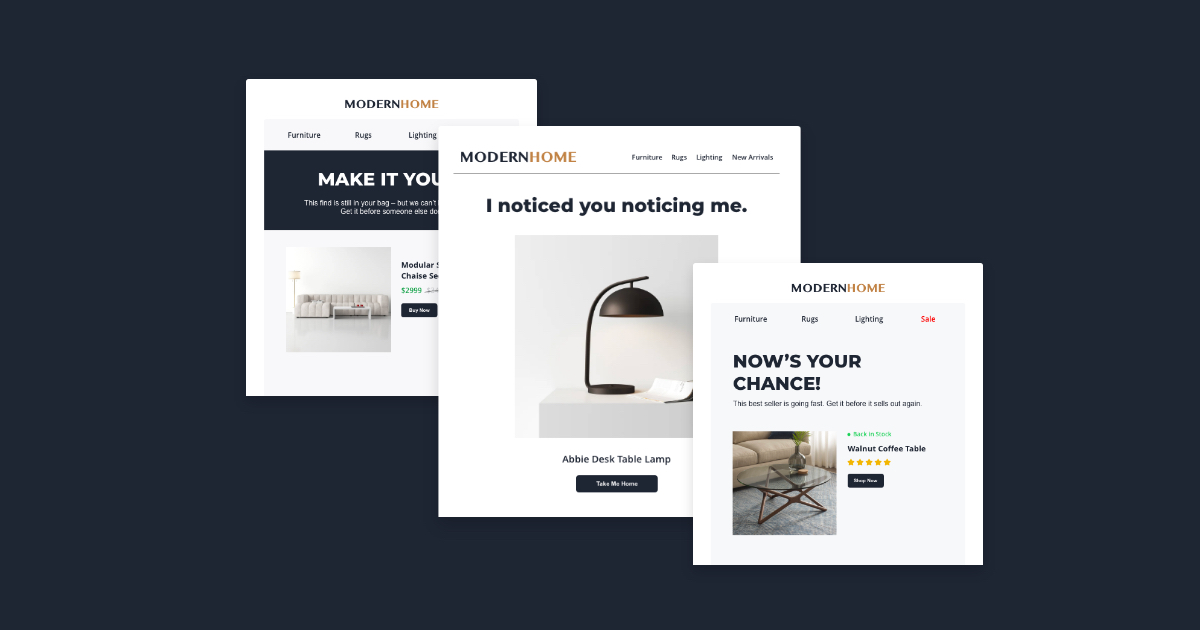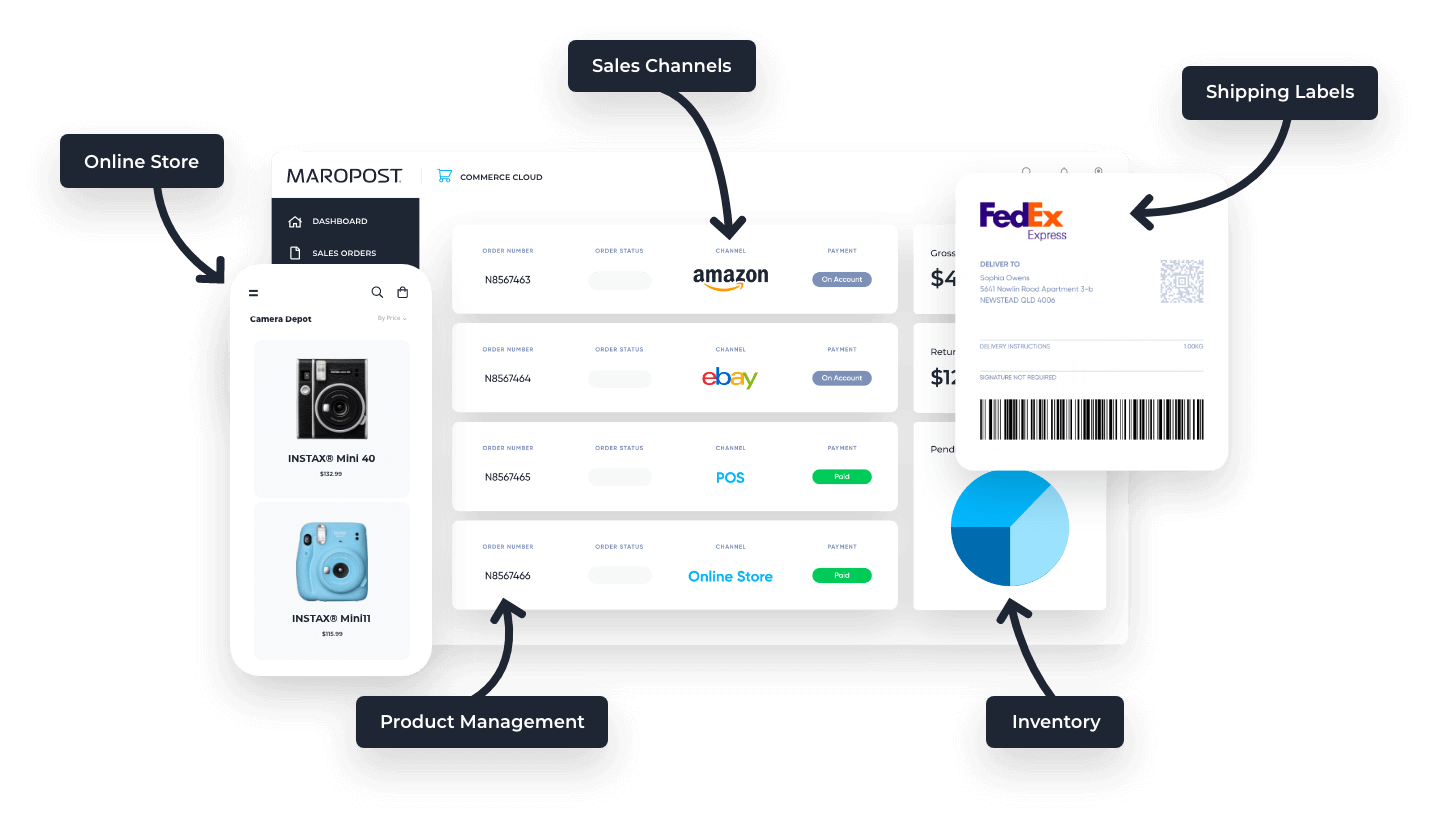Email marketing is perhaps the most important marketing channel to help businesses without a physical storefront connect with their customers. For those in ecommerce, email has the potential to produce massive revenue growth for your business.
However, it’s important to know the right types of campaigns to launch at the right time if you want to find success with the strategy and maximize your email ROI (return on investment).
Listed below are 5 email marketing examples that have worked successfully for popular ecommerce companies.
Use them as inspiration to inform your own marketing campaigns so you can connect with your customers in a relevant and timely way.
- Browse Abandonment Emails
- New Subscriber Welcome Email
- New Customer Welcome Email Series
- Cart Abandonment Emails
- Back in Stock Emails
1. Browse Abandonment Emails
The customer lifecycle refers to how customers interact with your brand at each stage of the buying process.
Understanding the customer lifecycle makes it possible for you to track and anticipate purchasing behavior so you can send targeted emails with the right message, to the right customers, at the right time.
Regardless of where they are in the customer journey, you can tell them what they need to hear to increase their chances of making a purchase.
This all begins with browsing when the customer first lands on your site. And it’s the reason browse abandonment emails are among the most important emails you can send.
Why?
Because we all know how much customers enjoy window shopping. Whenever a customer views some of your products, it’s the perfect opportunity for you to transform these window shoppers into actual paying customers.
How?
By tracking multiple browsing behaviors to identify buying intends and then creating behavioral triggers when a customer visits a product page/category a certain number of times without making a purchase.
You can track multiple browsing behaviors to help you identify buying intent. These include:
- Customers who look at the same product more than once
- People who browse multiple items in a single product category
- Customers who click on a specific product in an email
- Visitors who search a website for a specific product
How many browsing sessions is up to you. You can set this number as high as you want, but you must keep in mind that if you set the threshold too high, you will likely miss out on opportunities.
Here is an example of a browse abandonment email from Tipsy Elves:
2. New Subscriber Welcome Email
When users subscribe to your email list, not only are they being included into your outbound prospecting campaign, but they are also essentially taking the first major step toward making an actual purchase.
That’s why it’s crucial to keep the conversation going and start building deeper connections and longer-lasting relationships with those customers.
Your new subscriber welcome email can help you do just that. With it, you have the perfect opportunity to:
- Introduce your brand
- Show subscribers what to expect from your email series
- Guide your subscribers to the next step.
- Provide potential customers with resources to help them make more informed buying decisions
…and much more.
According to studies, welcome emails have an open rate that is 86% higher than other types of emails and are credited with generating, on average, 320% more revenue compared to other promotional emails.
This is reason enough for you to send subscriber welcome emails whenever someone signs up to your email list.
Here’s an example of a simple welcome email sent to a new subscriber by Virgin America:
For ecommerce businesses in beauty, fashion, and other niches with more visual products, this format might not work as well as one with images.
So instead, you may want to take advantage of dynamic pricing in your welcome email as in the example below from Moosejaw:
When should you send your new subscriber welcome email?
Your welcome series should be sent out immediately after the subscriber signs up. As previously mentioned, new subscriber welcome emails generate tons more opens and clicks than other promotional emails so don’t miss out on this huge opportunity for engagement and conversion.
3. New Customer Welcome Email Series
When considering the expense of acquiring new customers, the initial purchase is the least valuable (with regards to profit margin).
The subsequent purchases are what you need to focus on if you want to really maximize the lifetime value of your customers and explode revenue growth.
That’s where the new customer welcome email series comes in.
This is the email that you send after a customer makes their first purchase. You can use this email to grease the rails, so to speak, and increase the likelihood of future purchases.
This email has the following objectives:
- To welcome new customers to your brand
- To provide an excellent buying experience for your new customer
- To share your brand story with a simple email or hosting a monthly webinar.
When done right, this email can be a great opportunity for you to encourage your customer to make a second purchase and build a relationship.
Best practices for creating great customer welcome emails:
- Don’t stop at one. Send a series of welcome emails. Marketers usually send their customers three-to-five emails every week. Three emails is a great starting point.
- Include your customer and make them feel like they are part of your brand story.
- Use your first email to make a strong brand statement so you can establish trust and credibility.
- As part of your series, follow up with additional product information and support resources, such as how-to guides, product demo videos, instructional videos, etc. to help your new customer get the most from their purchase. If you’re looking for software to help with this, the Movavi video editor is one I’ve recently discovered that I absolutely love.
- Don’t forget to include information and links to your blog and social media profiles with a strong call to action for new customers to connect with you on other platforms.
- Write the proposal email to acquire new customers and support revenue growth with existing clients.
Pro Tip: In the third email, include a discount offer as a way to incentivize future purchases.
Here’s an example of a new customer welcome email after a purchase from Roark:
The email above gives the customers the information they need pertaining to their order.
But, this one from IKEA goes even further by offering information about the loyalty program, as well as product offers, and an invitation to read the blog and connect on social media.
4. Cart Abandonment Emails
According to recent statistics, 70% of products placed in ecommerce shopping carts are abandoned. This is one of the most frustrating things for anyone who deals with online sales.
After putting in so much effort to attract visitors to your site, optimizing your product pages, and doing a ton of other things to help persuade your visitors to agree to put an item in their cart, the last thing you want is for them to end up leaving without making the purchase.
There are a lot of reasons why this happens, ranging from:
- Unforeseen costs that were not in the initial quote
- Prospective customers shying away from creating an account on the site
- Overly complicated checkout processes that put off buyers
… and so on.
No matter the reason, when this happens, cart abandonment emails can help you convince customers to come back and complete the purchase.
Here is an example of an abandoned cart email from Dote:
How many abandoned cart emails should you send?
Send multiple emails. The right number will depend on your particular business, but you can conduct tests to find the right number of emails that achieve the highest conversions for you.
The key is to send a series of abandoned cart emails that will allow you to recover as many carts as possible.
Tips to make your abandoned cart email even more effective:
- You might offer alternatives by including images and links to other products that the user might find appealing.
- It’s also a good idea to use humor, catchy graphics, dynamic design, and other tactics that will get them to pay attention to the message in your email. To do this, you’ll need to find the right graphic design platform for your skill level.
- Also, make sure you include a sense of urgency in your abandoned cart email as a way to instill a sense of FOMO and encourage action from potential customers.
Here’s another example of a great abandoned cart email from a popular brand, Whisky Loot:
5. Back in Stock Emails
If a customer tries to buy a product, but it isn’t in stock, this is very inconvenient for both you and the customer.
Luckily, since the customer still has buying intent, this is a buying obstacle that is easy for you to remove by simply letting the customer know as soon as you have the item back in stock.
This is an easy behavioral trigger to detect, particularly if you are already sending your subscribers browse abandonment emails or cart abandonment emails.
When customers browse or add out-of-stock items to their shopping cart, sending them an email when the product once again becomes available is a great conversion opportunity.
Here is a perfectly executed back-in-stock email from Public Rec:
Conclusion
Hopefully, this article has provided you with a great place to start building successful email marketing campaigns for your ecommerce business.
Use these examples to inspire you to create unique and engaging automated sequences for ecommerce emails that are aligned with your customer’s journey. This will help you build stronger relationships with your subscribers and transform them into happy and satisfied repeat customers.
Need to chat about your mobile marketing strategy?
More than 10,000 marketers use Maropost to engage with their prospects and customers through emails, SMS, social media and more. We’re here to help you grow your business!
Chat Now


